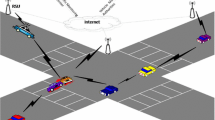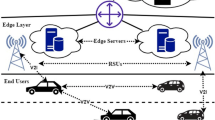Abstract
With the development of vehicle communication technologies, Vehicular Ad Hoc Networks (VANETs) through short distance communication technology achieve communication in Vehicle to Vehicular (V2V) and Vehicular to Infrastructure (V2I), which provides the basis for the implementation of application. However, the privacy and security of vehicle and message forwarding are vulnerably attacked by attacker due to the dynamic network topology. To address the problems, a Socially Aware Security Message Forwarding Mechanism (SASMF) based on trust assessment is proposed in this paper. Firstly, the pseudonym is used to protect the privacy of the vehicles, and the exchange entropy is as a measure to evaluate the exchange conditions of the pseudonym to avoid the continuous tracking of the vehicle by the attacker. Furthermore, according to the trust gradient, the message is forwarded in the form of multiple pieces of information to several relay vehicles and to the Application Provider (AP) through the Road Side Units (RSUs). Results show that the proposed mechanism can effectively improve the success rate of message forwarding and reduce the risk of message leakage and better protect the privacy of VANETs.




Similar content being viewed by others
References
Li L, Wen D, Yao D (2014) A survey of traffic control with vehicular communications. IEEE Trans Intell Transp Syst 15(1):425–432
Su Z, Hui Y, Yang Q (2017) The next generation vehicular networks: a content-centric framework. IEEE Wirel Commun 24(1):60–66
Yang Q, Zhu B, Wu S (2016) An architecture of cloud-assisted information dissemination in vehicular networks. IEEE Access 4:2764–2770
Zhou L (2016) On data-driven delay estimation for media cloud. IEEE Trans Multimedia 18(5):905–915
Wu D, Liu Q, Wang H, Wu D, Wang R (2017) Socially aware energy efficient mobile edge collaboration for video distribution. IEEE Trans Multimedia PP(99):1–1
Wu D, Yan J, Wang H, Wu D, Wang R (2017) Social attribute aware incentive mechanism for device-to-device video distribution. IEEE Trans Multimedia 19(8):1908–1920
Zhang H, Ma Y, Yuan D, Chen HH (2011) Quality-of-service driven power and sub-carrier allocation policy for vehicular communication networks. IEEE J Sel Areas Commun 29(1):197–206
Dötzer F (2005) Privacy issues in vehicular ad hoc networks. International Workshop on Privacy Enhancing Technologies 3856:197–209
Zhang C, Lin X, Lu R, Ho PH, Shen X (2008) An efficient message authentication scheme for vehicular communications. IEEE Trans Veh Technol 57(6):3357–3368
Yang Q, Lim A, Li S, Fang J, Agrawal P (2010) Acar: Adaptive connectivity aware routing for vehicular ad hoc networks in city scenarios. Mobile Networks & Applications 15(1):36–60
Lei H, Gao C, Guo Y, Pan G (2015) On physical layer security over generalized gamma fading channels. IEEE Commun Lett 19(7):1257–1260
Luo T, Kanhere SS, Das SK, Tan HP (2016) Incentive mechanism design for heterogeneous crowdsourcing using all-pay contests. IEEE Trans Mob Comput 15(9):2234–2246
Bouksani W, Bensaber BA (2017) An efficient and dynamic pseudonyms change system for privacy in vanet. In: 2017 IEEE Symposium on computers and communications (ISCC), vol 00, pp 59-63. https://doi.org/10.1109/ISCC.2017.8024505
Lu R, Lin X, Luan TH, Liang X, Shen X (2012) Pseudonym changing at social spots: an effective strategy for location privacy in vanets. IEEE Trans Veh Technol 61(1):86–96
Beresford AR, Stajano F (2004) Location privacy in pervasive computing. IEEE Pervasive Comput 2 (1):46–55
Buttyán L, Holczer T, Vajda I (2007) On the Effectiveness of Changing Pseudonyms to Provide Location Privacy in VANETs. Springer, Berlin
Dahl M, Delaune S, Steel G (2010) Formal analysis of privacy for vehicular mix-zones. In: Computer Security - ESORICS 2010, European Symposium on Research in Computer Security, Athens, Greece, September 20-22, 2010. Proceedings, pp 55–70
Shamir A (1979) How to share a secret, vol 22, pp 612–613
Tang D, Ren J (2016) A novel delay-aware and privacy-preserving data-forwarding scheme for urban sensing network. IEEE Trans Veh Technol 65(4):2578–2588
Xiong J, Zhang Y, Li X, Lin M, Yao Z, Liu G (2018) Rse-pow: a role symmetric encryption pow scheme with authorized deduplication for multimedia data. Mobile Networks & Applications 23(3):650–663
Xia Y, Chen W, Liu X, Zhang L, Li X, Xiang Y (2017) Adaptive multimedia data forwarding for privacy preservation in vehicular ad-hoc networks. IEEE Trans Intell Transp Syst 18(10):2629–2641
Peng M, Li Y, Jiang J, Li J, Wang C (2014) Heterogeneous cloud radio access networks: a new perspective for enhancing spectral and energy efficiencies. IEEE Wirel Commun 21(6):126–135
Luo C, Yang LT, Li P, Xie X (2015) A holistic energy optimization framework for cloud-assisted mobile computing. IEEE Wirel Commun 22(3):118–123
Zhang Z, Wang L, Liu D, Zhang Y (2016) Peer discovery for d2d communications based on social attribute and service attribute. Journal of Network & Computer Applications 86
Wu D, Zhang F, Wang H, Wang R (2018) Fundamental relationship between node dynamic and content cooperative transmission in mobile multimedia communications. Comput Commun 120
Wu D, Zhang P, Wang H, Wang C, Wang R (2016) Node service ability aware packet forwarding mechanism in intermittently connected wireless networks. IEEE Trans Wirel Commun 15(12):8169–8181
Wang R, Yang H, Wang H, Wu D (2016) Social overlapping community-aware neighbor discovery for d2d communications. IEEE Wirel Commun 23(4):28–34
Guo JJ, Ma JF, Guo XX, Li XH, Zhang JW, Zhang T (2018) Trust-based service composition and selection in service oriented architecture. Peer-to-Peer Networking and Applications 11(5):862–880
Wu D, Si S, Wu S, Wang R (2017a) Dynamic trust relationships aware data privacy protection in mobile crowd-sensing. IEEE Internet Things J PP(99):1–1
Wu D, Zhang F, Wang H, Wang R (2017) Security-oriented opportunistic data forwarding in mobile social networks. Future Generation Computer Systems
Yan J, Wu D, Sanyal S, Wang R (2017) Trust-oriented partner selection in d2d cooperative communications. IEEE Access PP(99):1–1
Chen Y, Wei Y (2013) A beacon-based trust management system for enhancing user centric location privacy in vanets. J Commun Netw 15(2):153–163
Yang Q, Wang H (2015) Toward trustworthy vehicular social networks. IEEE Commun Mag 53(8):42–47
Elizabeth BL, Aaishwarya R, Kiruthika P, Shrada MN, Prakash AJ, Uthariaraj VR (2011) Bayesian based confidence model for trust inference in manets. In: International conference on recent trends in information technology, pp 402–406
Wang R, Yan J, Wu D, Wang H, Yang Q (2018) Knowledge-centric edge computing based on virtualized d2d communication systems. IEEE Commun Mag 56(5):32–38
Zhang Z, Zhang P, Liu D, Sun S (2017) Srsm-based adaptive relay selection for d2d communications. IEEE Internet Things J PP(99):1–1
Zhou L, Wu D, Chen J, Dong Z (2017a) When computation hugs intelligence: content-aware data processing for industrial iot. IEEE Internet Things J PP(99):1–1
Zhou L, Wu D, Dong Z, Li X (2017b) When collaboration hugs intelligence: content delivery over ultra-dense networks. IEEE Commun Mag 55(12):91–95
Jiang D, Huo L, Lv Z, Song H, Qin W (2018) A joint multi-criteria utility-based network selection approach for vehicle-to-infrastructure networking. IEEE Trans Intell Transp Syst PP(99):1–15
Rabieh K, Mahmoud MMEA, Younis M (2017) Privacy-preserving route reporting schemes for traffic management systems. In: IEEE international conference on communications, pp 7286–7291
Acknowledgements
This work is partially supported by the National Natural Science Foundation of China (61771082, 61871062), Program for Innovation Team Building at Institutions of Higher Education in Chongqing (CXTDX201601020).
Author information
Authors and Affiliations
Corresponding author
Additional information
Publisher’s Note
Springer Nature remains neutral with regard to jurisdictional claims in published maps and institutional affiliations.
Rights and permissions
About this article
Cite this article
Yang, P., Deng, L., Yang, J. et al. SASMF: Socially Aware Security Message Forwarding Mechanism in VANETs. Mobile Netw Appl 25, 660–671 (2020). https://doi.org/10.1007/s11036-019-01223-9
Published:
Issue Date:
DOI: https://doi.org/10.1007/s11036-019-01223-9




